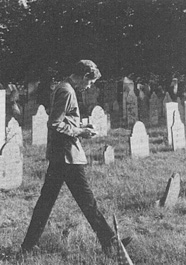 | James Fanto Deetz1930-2000 |
 | James Fanto Deetz1930-2000 |
| The following tribute by Marley Brown, III, one of Jim Deetz's students and colleagues, was published to commemorate Jim's career, lifetime achievements, and contributions to archaeology. This memorial article first appeared in the Summer 2004 edition of Historical Archaeology journal, Vol. 38, No. 2, pp. 103-23. |
On Saturday, 25 November, 2000, historical archaeology lost one of its brightest lights, a scholar who did more than anyone of his generation to define the scope of the field and place it securely within the fold of anthropology. James Deetz's passing barely two months shy of his 71st birthday also silenced one of the most talented teachers ever to grace the halls of America's universities. His final battle with a chronic illness brought his family members and close friends to his bedside in Charlottesville. Nearby at Jim's sister's house, his children tried to celebrate Thanksgiving, the holiday whose traditions their father had so cleverly exposed in his 1969 essay "The Reality of the Pilgrim Fathers" (Deetz 1969). The irony of the timing of his passing was not lost on Jim's friends. One headline written a week after his death read simply, "Pilgrim scholar Deetz dies after his holiday." Less than a month before he died, we had been treated to his further debunking of the Pilgrim myth in the first chapter of Jim's last book, The Times of Their Lives: Life, Love, and Death in Plymouth Colony (Deetz and Deetz 2000). Written with his second wife, Patricia Scott Deetz, The Times of Their Lives reflects on the results of the most important archaeological and historical research he did there in the 1960s and early 1970s. With the assistance of his wife and some of his University of Virginia (UVA) graduate students, Jim was able to expand on his original work and take care of some important unfinished business. We are fortunate that so much of his work is now also accessible to us online at the wonderful Plymouth Colony Archives Web site created and maintained by Chris Fennell and supported by UVA. There, too, can be found an extensive collection of information about Jim's career. 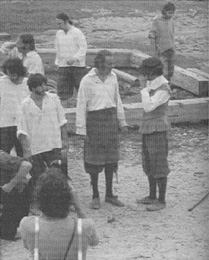 In this final book, Jim also recounted what surely must have been some of the "times of his life." At least they seem that way to someone like me who shared so intimately in them. His account is enlivened by reminiscences of celebrations of Thanksgivings past, such as the 1971 Turkey Day when the Deetz family hosted several busloads of Native Americans who were in Plymouth to observe their National Day of Mourning. He also used the published work of the well-known playwright and actor Sam Sheppard to further engage us in his analysis of what Plymouth meant to him and what it means to us today as a memorial landscape. Sheppard was one of Bob Dylan's many camp followers on the 1976 tour known as the Rolling Thunder Review. It was the bicentennial year, and what better place to begin a national tour than the "birthplace of America." Sheppard's trenchant commentary on the tour's first stop in Plymouth provided Deetz with a useful counterpoint for his own interpretation of the Plymouth experience. The gathering in the fort with Bob Dylan and Joan Baez occurred in the year of Jim's last Thanksgiving celebration at Plymouth. But partying with famous folkies in what many of us considered "the other village" was not what made Jim Deetz's tenure in Plymouth memorable, nor was it his revisionist take on the Pilgrim's first Thanksgiving. Between 1967 and 1978, Jim created the most exciting living history museum ever-the outdoor reconstruction known as Plimoth Plantation devoted to the Pilgrims of 1627 and later embracing their Wampanoag neighbors. He built Plimoth on the back of careful archaeological and historical research, undertaken by a dedicated group of historians and interpreters who increasingly embraced Deetz's vision of a Pilgrim village peopled by the very individuals known to have lived there, dressed in the most accurate of period clothing, even speaking in the dialects of their English county of origin. Deetz's impact on the world of living history museums may have been a surprise for some who saw him foremost as a "new archaeologist," a scholar purportedly more interested in hypothesis testing than role-playing. But this flair for the dramatic in the interpretation of the past would not have surprised his classmates at Fort Hill High School in Cumberland, Maryland. James Deetz was born in Cumberland in 1930 to John Harold Deetz and Catherine Fanto Deetz. He and his younger sister, Barbara, spent their entire childhood there. Although he became known around town for his bird watching and butterfly collecting, by the time he was a senior in high school, Jim's lepidopterist pursuits had to make room for his thespian pretensions. By senior year he had become the school's most prominent leading man, a member of both the Fort Hill High Players and a National thespian. He went to Harvard in fall 1948 to prepare for medical school, not drama school, but no one who had the pleasure of experiencing Jim in front of a lecture hall podium would ever doubt his acting skills. Harvard, Back to Harvard, and Harvard Again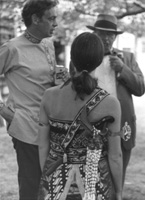 Deetz did not stay with his pre-med concentration long, switching to anthropology after a very stimulating introductory course in the subject and a very disappointing grade in chemistry. J. O. Brew, director of the Peabody Museum and Jim's main mentor throughout his time at Harvard, set him up with his first excavation. In June 1950 he became a member of Don Lehmer's field crew at the Dodd site in South Dakota, a project sponsored by the Missouri River Basin Survey run out of Lincoln, Nebraska. Jim stayed on into the fall and as a result was drafted (the Korean War had broken out the same month he had left to join the excavation crew). He joined the Air Force in early 1951 and found his undergraduate education interrupted for five years. He served all over the country, but his most difficult posting was in Greenland. While there, Deetz kept up his interest in anthropology in two ways. He took an extension course on California Indians through the University of California Extension Service, and he initiated his own excavation of a recently abandoned village site. As he once told me, the extension course came in handy when, during his PhD orals, Clyde Kluckhohn asked him to name all the tribes in California, starting with San Diego and the coast and going north, coming down the valley, and then back up the Sierra. Jim succeeded and sometimes felt a need to ask at least one comparable question to his own PhD students during their orals. Deetz's excavation was not so successful. Although it didn't damage his subsequent career, his Greenland dig created an international incident at the time, not having the proper permission from the king. I asked him why he would risk offending the Danish government and he told me, You had to have been there, but if you're stuck with 10 other guys in a shack on a mountaintop for a year, half of which is always dark and the other half is always daylight, you've got to find something to do. Well, I'm a birdwatcher, so I watched the birds, and I collect butterflies, so I collected the only butterfly that was there, so I had one butterfly and that was that, and then I found this site down by the fjord (James Deetz, 26 August 1989, Berlekey, CA, pers. comm. [interview with Marley Brown]). Deetz was hard at work plotting caribou bone element distributions before his project was shut down by two investigating archaeologists sent up from the War College (Jim described his effort as "doing a kind of pre-Binford whatever"). He carefully mapped the bones on the site in relation to the house pits and then reconstructed them in a vacant barracks building. His undoing came when the Danish liaison officer was invited to an exhibit he mounted in the base theatre. Soon thereafter, the Danish officials lodged a formal protest with Washington. During his four years in the Air Force, Deetz also met and married his first wife, Eleanore Joanne (Jody) Kelley. They married in 1953 upon his return from Greenland and started their family when Jody gave birth to eldest son James Christian (Jamey) in 1954. Deetz returned to Harvard after his discharge from the Air Force in January 1955. To get ready for his return to school, Deetz went to see Hal Movius. Jim was both surprised and pleased to be remembered after a five-year absence. Movius became his advisor, and that spring Deetz began "reading everything he could get his hands on" in anticipation of finishing up his undergraduate studies. He took classes from A. V. Kidder, Earnest Hooton, and Leslie Spier, which he remembered as being "pretty amazing. Anybody who had a course from Leslie Spier, it was like saying you had a course from Louis Henry Morgan" (Deetz, 1989, pers. comm.). He characterized much of this course work as "the most painful recitation of classic, mid-thirties trait listing. Very Boasian but with no integration" (Deetz, 1989, pers. comm.). Although Jim led me to believe that he found the emphasis of so many of his Harvard classes, both before and after the Korean War, to be "regrettable" in their exclusive attention to traits and sequences, he learned them well. Lecture notes from his classes on archaeology during the 1960s reveal that Deetz most certainly shared in some aspect of this approach in his teaching. As he was finishing up his bachelor's degree, Deetz found other helpful faculty at Harvard. He began to spend more time with Gordon Willey, and it was Willey who persuaded him to stay at Harvard for his PhD. Deetz was planning to go to Arizona, but Willey assured him that the department would find money to support his graduate study. During his senior year he worked with William H. Howells, for whom he was a teaching assistant, and maintained his close association with J. O. Brew. As Jim recollected, Brew, as director of the Peabody, was always willing to see people in his office, "but he never really saw you in his office, he walked in and he walked out and you followed him out and you stood in the front hall and talked" (Deetz, 1989, pers. comm.). Often in the group standing around at the Peabody while Jim chatted with Brew would be fellow students Clifford Geertz and Dell Hymes. Jim officially received his bachelor's degree from Harvard in June 1957 (cum laude) and, true to his promise, Willey helped Deetz secure fellowships so that he could stay on and do his dissertation. That same year, his second son, Joseph Dayton (Joey), was born, joining an elder sister, Antonia (Toni), born the year before. 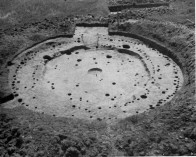 After graduating, Deetz returned to the Missouri River Basin Survey in summer 1957. He spent the first part of the summer on Herbert Smith's crew, searching for an 18th-century French fort but finding only a modern reservation-era house (ca. 1920). I once asked Jim if this first foray into the modern period of historical archaeology had any influence on his career. His response was, "Yeah, it had a negative impact. I swore I'd never do it again" (Deetz, 1989, pers. comm.). Luckily for Deetz, he was able to transfer across the river to a crew being led by fellow Harvard graduate student Bill Irving, excavating the large multi-component site known as Medicine Crow. As Deetz tells it, Irving wasn't interested in the Middle-Missouri components. He turned the earth lodges over to Jim, so he could pursue a much earlier occupation with intact hearths. Deetz returned to the site the next summer to complete this project. In his approach, he was able to call on the techniques learned under Lehmer's supervision during the summer of 1950. Deetz also recalled a conversation he had had with a fellow crewmember from that first summer on the Missouri, Frank Livingstone, who went on to study sickle-cell anemia. As they were working on one of the later Arikara-period lodges, Livingstone made a casual observation about how pottery with certain designs seemed to be clustered in different structures. This idea stuck with Jim, although he would not recall it in detail until the artifacts from his second summer of excavation at Medicine Crow had been shipped back to Cambridge. Early in fall 1958, Deetz began to examine the ceramics from later phases at Medicine Crow. It dawned on him that, as he described it, "something is going on here. I thought a little more about what Frank said and then one day the light went on in my head" (Deetz, 1989, pers. comm.). Quite excited by his discovery, Jim approached the first person he saw, who happened to be Clyde Kluckhohn: "I grabbed Clyde and dragged him out there and I showed him what I thought was going on and for the first time we actually had a conversation where I could understand him and he could understand me. And he managed to get me some money to pay for the computer time" (Deetz, 1989, pers. comm.). 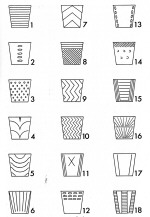 Jim needed to call in a number of favors to get help from some students at the Massachusetts Institute of Technology who had access to a mainframe the "size of a city block." They would run his data from Medicine Crow whenever there was free time, often in the middle of the night. He took the printouts and worked the data until he had defined the trends through time in the association of design attributes that became the basis for his ideas about changing residence patterns (and, by inference, changing descent systems). Based on the work he did during his second year of graduate study, Deetz produced a dissertation entitled "An Archaeological Approach to Kinship Change in Eighteenth Century Arikara Culture" (Deetz 1960a), for a committee composed of Kluckhohn, Brew, Howells, and Stephen Williams. The latter was his official advisor by virtue of being the full-time North American archaeologist on the faculty when Deetz submitted his dissertation in spring 1960. Though he had completed his dissertation by mid-1959, he had to wait until 1960 to defend. He was awarded his doctoral degree in June of that year, just about five years after he had returned to Harvard for his junior year. One day during early spring 1959, while Deetz was engrossed in his analysis of the Medicine Crow ceramics, Brew came out of his office and yelled up to the Peabody's mezzanine level to get Jim to come down to meet someone. The visitor was Harry Hornblower, who along with Brew, Ripley Bullen, John Howland Rowe, Chester Chard, and others, had been a member of the Harvard Excavator's Club in the early 1940s. Harry was looking for someone to advise on the construction of an Indian camp to be put in the Pilgrim village at Plimoth Plantation, the museum established on his family's estate in Chiltonville, Massachusetts. Jim went down to check out Plymouth over the next weekend, and after meeting most of the plantation staff, he agreed to move his family down to one of the houses owned by the plantation opposite the Plymouth town beach. Taking the trip that summer were Jim and his wife and their four children. Second daughter Kristen (Cricket) had been born early that year. Once settled in the beach house, Jim contributed to the design of the plantation's Indian camp but put most of his effort into his first real excavations on historic sites-sites associated with families of the "Pilgrim Fathers." The most interesting of these was the Joseph Howland site located in the Rocky Nook section of nearby Kingston, Massachusetts. Jim was taken to the site by a local amateur archaeologist, Arthur Vantangoli, who would become one of the plantation's most valuable archaeological volunteers. When asked how he decided where to dig, Jim observed that he "just put a hole beside the big stone with a bronze plaque on it" (Deetz, 1989, pers. comm.). Soon confronted with some pieces of a Westerwald-type stoneware mug, Jim recalled, "I thought somebody had busted a beer stein there that they had brought back from Munich" (Deetz, 1989, pers. comm.) |
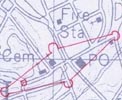 |  |
| Deetz readily admitted that he began the excavation of the Howland site lacking "an intimate familiarity with the artifacts." But he soon caught up, using such sources as Ivor Noël Hume's Here Lies Virginia (1963) and John Cotter's synthetic report on the Jamestown excavations (1958). Jim published two articles about the site, both published by the Howland Family Association's newsletter Howland Quarterly in 1960 (Deetz 1960b, 1960c). These two articles, really his first publications, show the same concern for phasing and chronology that so occupied Deetz in his analysis of the ceramics from the Arikara phase of Medicine Crow. Stratigraphic controls were in place, and Deetz paid special attention to the problem of separating fill from actual occupation deposits, much as he had learned from Don Lehmer at the Dodd site. Nonetheless, he was able to adapt J. C. Harrington's approach to pipestem dating (Harrington 1954) to the problem of chronology at the Howland site and used the pipes to divide a 75-year occupation span into three phases. Almost 30 years later, Deetz would return to pipestem dating and offer other innovative applications of the Harrington technique: first to discover periodicities in site occupation spans at Flowerdew Hundred (Deetz 1987a) and, subsequently, to help in understanding the occupation sequence at an early Dutch fort in South Africa (Schrire et al. 1990). In choosing to emphasize pipestems and the implications of "bimodality" in their distribution at the Howland site, Deetz was simply engaging in the kind of pattern recognition that made him such a brilliant archaeologist. He is rightly credited with some very innovative work in his study of stylistic motifs appearing on Arikara ceramics. In fact, his interpretation of the Arikara evidence in terms of changing residence patterns was the first of its kind to appear, predating dissertations on similar phenomena within southwestern pueblos by several years (Longacre 1963; Hill 1965). Using today's popular parlance, it can be said that Deetz's interpretation of Arikara ceramics and their spatial and temporal dynamics was a striking example of practice theory applied in the context of Contact period archaeology. As Deetz once reminded me, his dissertation came out in 1960, and it delved deeply into descent systems and kinship terminology. By the time his dissertation was published in 1965, much had changed, including the dissemination of the work on Broken K Pueblo and Carter's Ranch (Hill 1965). Deetz credited an extensive prepublication review of his manuscript by Irving (Ben) Rouse for the shift in emphasis from descent systems to residence, the latter viewed as a direct representation, to use his words, of "the proceedings of social interaction" (Deetz, 1989, pers. comm.). Rouse also steered him away from unilocality to multilocality in his understanding of the breakdown of what had formerly been for the Arikara an "orderly process of interaction," a normal routine that had progressively broken down under the pressures of contact. The Santa Barbara Years (Summers Back East)During 1959 and 1960, the Deetz family joined "the summer people" of Plymouth as Jim directed excavations at the Howland site. But after he received his doctorate, Deetz's career moved into high gear. He was hired to teach at the University of California at Santa Barbara and Jim's transition from graduate student to faculty member was quick and far-reaching. He became professionally active in a way he had consciously avoided as a graduate student. He established his reputation as a brilliant teacher of undergraduates. Right after arriving in Santa Barbara, Deetz joined colleagues Roger Owen, Jack Chilcott, and Tony Fisher in teaching a National Science Foundation-sponsored summer institute for high school teachers, a kind of program that he would return to in earnest at his last major field project at Flowerdew Hundred in the late 1980s and early 1990s. The institute on the campus of the Midland School greatly altered his career because among its most eager participants was Edwin (Ted) Dethlefsen, a biology teacher at Midland. Ted and Jim became good friends. When Ted decided he wanted to continue his education, Jim helped him get into the PhD program at Harvard. They also used work they did together during summer 1961 at the site known as Alamo Pintado, an historic Chumash village site, as the basis for their first coauthored article on the use of soil chemistry in archaeology (Deetz and Dethlefsen 1963). Deetz also published a brief note on a pictograph from this site in a 1964 volume of American Antiquity (Deetz 1964). It was the second collaboration between Deetz and Dethlefsen, however, that attracted all of the attention. 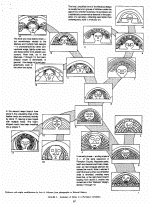 Deetz has described the details of their mutual discovery at the Concord, Massachusetts, cemetery at length "down to the brand of ale that he and Ted were drinking" (Deetz 1989:ix-xiv). Jim had returned to Harvard to teach during the 1963 summer session. Dethlefsen was his teaching assistant. One hot afternoon they were "cooling their heels" in the Concord cemetery, and Ted pointed out to Jim how the styles of decoration on different stones seemed to change with time. From the beginning Deetz saw the gravestone studies as a kind of "experimental historical archaeology." He and Dethlefsen shared authorship on a very important series of articles published between 1965 and 1971. Deetz formulated most of the substantive analysis and wrote all of the papers. His two favorites were the first paper on the Doppler Effect (Deetz and Dethlefsen 1965) and the last on the subregional manifestation of stylistic variability (Deetz and Dethlefsen 1971). He admitted to me that a colleague told him, after hearing his ideas about how the position of the observer seemed to influence the workings of seriation, that, "hey, man, that's the Doppler effect" (Deetz, 1989, pers. comm.). After applying the formula and, as he recollected, "seeing how nicely it fit," he said "I used to think for awhile that it was one of those cases where human behavior might follow some kind of principle defined primarily out of the physical world" (Deetz, 1989, pers. comm.). Deetz and Dethlefsen's final co-authored gravestone publication gave Jim an opportunity to disabuse himself of such heresy. In that paper, he presents a set of structural principles to account for the localized stylistic transformations he had traced in several cemeteries, principles that were more in line with the linguistically inspired interpretation he was turning to at the beginning of the 1970s. During his tenure on the faculty at Santa Barbara (he began as instructor of anthropology in fall 1960 and left as a full professor in 1967), Deetz was instrumental in helping build a small department into a very important one. Recruitment of distinguished faculty, including Albert Spaulding from Oregon and Tom Harding from Michigan, continued and culminated in a major transfer of talent from Michigan to Santa Barbara, bringing Loring Brace and Elman Service to campus. These were years of exceptional colleagueship for Jim, a time when close friends were made and much productive collaboration occurred. In addition to the summer institute, Deetz joined Roger Owens and Anthony Fisher in putting out a collection of sources on Native Americans (Owens et al. 1967) and reported on the value of "simulated" archaeological sites for teaching excavation techniques in an article written with lifetime friend John (Jack) Chilcott (Chilcott and Deetz 1964), who later joined the faculty at the University of Arizona. The Chilcotts and Owens also provided the Deetz kids with excellent companionship, and friendships made in those years among various children endured the subsequent relocation of all the families. And in the Deetz case, the family continued to grow. Jim and Jody welcomed three more children into an increasingly crowded house in Montecito, California. Sons John Eric (Eric), William Geoffrey (Geoff), and Joshua Andrew (Josh) were born in 1960, 1962, and 1963, respectively, and daughter Cynthia (Cindy) came along in 1964. During his Santa Barbara years, Deetz also discovered that he owned some very interesting and valuable Indian baskets, acquired in antique stores in and around Cambridge while he was still in graduate school. Once in Santa Barbara, he figured out that one of them was Chumash. Wanting to know more, he found help in the person of Lawrence (Larry) Dawson, then a curator at the Lowie Museum at the University of California at Berkeley. Jim met Larry at a Southwestern Anthropological Association meeting, and their collaboration was very productive, resulting in an exhibit on Chumash art and a survey of Chumash basketry (Dawson and Deetz 1964, 1965). Deetz put some of his newly gained insights about basketry into the introductory book he was writing in summer 1966. He also incorporated lessons and case studies into the book from all the excavations he had worked on up to that point, including the highlights of his 1963 summer season at La Purisima Mission in Lompoc, California. Deetz took on the California project at the request of Fritz Riddell of the Department of Parks and Recreation. With the help of a very able crew, including two people who would follow him to Plymouth the next year, Deetz oversaw an impressive program of excavation and interpretation. His careful recording and analysis of La Purisima's Indian barracks yielded important insights into differential rates of change in gender-based productive activities among Indian neophytes, while close attention to some artifacts recovered from the tanning vats produced a compelling example of what today would be called creolization (Deetz 1963:186-189; 1967:114, 116). 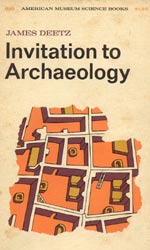 Published by Doubleday in 1967, Deetz's Invitation to Archaeology became an instant classic, a book that effortlessly introduced basic concepts, such as stratigraphy and seriation for the first year student, and presented a complex model of the relationship between behavioral patterning and assemblage variability that took advantage of all of his prior research. This book also introduced a brand-new linguistic model for the manufacture of artifacts, one whose origins reach back to the several linguistics courses he took at Harvard but that was directly inspired by conversations he was having with friend Loring Brace and colleague Margaret Mead. He had come to know Mead during her term as a visiting scholar at Santa Barbara. Jim credited Douglas Oliver, another former Harvard professor of his, with the introduction to the Doubleday editor. Oliver had already written an introduction to cultural anthropology (Oliver 1964) and thought Deetz would do a good job with a similar volume on archaeology. Deetz and the Doubleday editor agreed, and Jim sat down and wrote the book in four weeks. He sent in the manuscript and then realized, as he put it, "my God, they have my manuscript and I don't have a contract. I hope they're honest." It turned out they were. Invitation to Archaeology was a top best seller of such academic texts for more than a decade. The Brown/Plymouth Years or Back and Forth on Route 44Deetz also credited Oliver with his move in 1967 from Santa Barbara to Brown University. As Jim told it, Doug knew they were looking for an archaeologist and he gave them my name and he kept saying to me when he'd see me at meetings, well you ought to think about Brown. Then Reagan was elected [governor] and we were young and idealistic and dumb, and we had all these protests and thought, well what the hell. Times have changed. We went back to Plymouth (Deetz, 1989, pers. comm.). Of course, Deetz was no stranger to Plymouth, even during his seven years at Santa Barbara. He had spent several summers there, along with a sabbatical year at Harvard during academic year 1965-66. In fact his archaeological adventures during one of these summers, 1966, is chronicled in the well-known hit film Colonial Six. During its run, this film made by Plimoth Plantation was the only introduction to the techniques of historical archaeology available for the classroom. The site itself, associated with Major John Bradford, was not very interesting, but the film held up very well over the years. Because Jim had kept up his close association with the plantation, it came as no surprise that the arrangement negotiated to bring him back to serve on the Brown faculty included a half-time appointment at the plantation. After a year, the museum's director, David Freeman, offered Deetz the position of assistant director, wanting him to be responsible for research, exhibits, and visitation. Jim immediately took action to improve the exhibits. As he recalled the plantation in those years, "It was terrible. Mannequins in all the houses. Red metal foil embers, rubber fish, sawdust cornmeal. And what struck me was that the visitors would spend something like 45 seconds in each house. I mean there was nothing to see" (Deetz, 1989, pers. comm.). It took Jim some time to implement the kind of changes he had in mind, in part because of the opposition of members of the Society of Mayflower Descendants. Among those he brought in to help were Cathy Gates and Dick Humphrey, who had been instrumental in the success of his work at La Purisima. Gates was put to the task of detailed furnishings research, with the goal of identifying the kinds of objects that should be in the houses. Probate inventories figured prominently in this research, as did the results of excavations stretching back to Harry Hornblower's efforts with the Excavator's Club. With assistance from historian John Demos at Brandeis, Deetz also initiated a systematic program of population reconstitution or mass biography. Without access to computers, all of this research was compiled with the help of a byzantine (by modem standards) system of punch cards. Jim also hired someone steeped in the techniques of role-playing to begin the process of training interpreters. In three years there was a noticeable change in the physical appearance of the village, living history was increasingly in evidence, and historical research sponsored by the plantation began to appear in a series of important publications by soon-to-be-prominent historians (Rutman 1967; Demos 1970). As Jim took to his job at the plantation, he became, as he put it, "completely turned on to what amounts to American studies, which is not surprising because clearly the plantation was a very integral part of what American studies would be. And that came from first reading Glassie's book Pattern in the Folk Material Culture of the Eastern United States [Glassie 1968] and meeting him on Halloween night 1969" (Deetz, 1989, pers. comm.). Running into Henry Glassie at the American Studies Association meeting in Toledo, Ohio, was a memorable event for Deetz and they got along famously from the very beginning. Jim recalled, "actually for the first 10 minutes Pattern in the Material Culture of the Eastern United States met Invitation to Archaeology because we had each read the other's book" (Deetz, 1989, pers. comm.). They sat together at the banquet, "right up by the head table and after the dinner was over the program chair stood up and said 'We will now hear six papers on Walt Whitman,' and the two of us looked at each other and without saying a word, stood up, walked out, followed by a bunch of grad students, and headed to the bar" (Deetz, pers. comm., 1989). Hearing this account of their behavior at their first meeting banquet together gave me a much better understanding of my subsequent experiences sitting with Henry and Jim at various SHA banquets during the 1970s. If his responsibilities at the plantation exposed him to brand-new audiences, such as those attending his panel at the American Studies Association, his faculty position at Brown brought Deetz into contact with an undergraduate community eager for interaction with a teacher of his caliber. The sherry hours with Jim as a guest were standing room only in 1968, and the popularity of his introductory course was such that they had to move his lectures to the largest auditorium available, Pembroke's Alumnae Hall. Where once a roomful of 90 would have been noteworthy, a lecture class of 350 was commonplace for Deetz (these numbers may seem small compared to what he achieved both before and after at much larger universities, but this was Brown, after all). Right away Deetz attracted the interest of students who would go on to study anthropology at the graduate level. A number of his Brown undergraduates have become very prominent archaeologists in their own right, but, interestingly, many are not historical archaeologists. By the early 1970s, as well, Deetz had recruited a small corpus of graduate students. The ranks swelled in fall 1973 when a large class entered whose collective identity did much to create the sense of a distinctive Brown graduate program in historical archaeology. There is no question that this group of Brown students identified with a set of common goals and strove to accomplish them in their individual scholarship. Deetz was able to reproduce at Brown the great success he enjoyed at Santa Barbara, with the added benefit of doctoral students who had not been present there, at least in anthropology. What is so impressive, though, is the fact that he would do so twice more, having similar impact on the students at Berkeley and at UVA. This track record is clear testimony to his exceptional skills as a teacher at all levels. Beyond the courses that had become standards for him, such as introductory prehistory and physical anthropology and archaeological methods, Deetz developed a brand-new offering, reflecting his turn towards American studies. First taught in fall 1971, American Material Culture drew a goodsize class for an upper-level undergraduate lecture course. He used his and Glassie's books, along with a new reader he had just compiled for Little Brown. This new book, Man's Imprint from the Past (Deetz 1971), brought together all of Jim's favorite articles on what he considered to be the essentials of archaeological method. Putting these classics such as Spaulding's "The Dimensions of Archaeology" and Brew's "The Use and Abuse of Taxonomy" together with case studies of gravestones, vernacular architecture, and historic ceramics really worked. 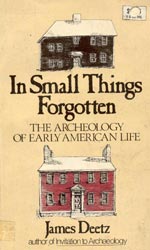 Word got around, and enrollments for this class grew rapidly. Not only was this course the basis for his next major book, In Small Things Forgotten, published in 1977, American Material Culture became a staple course offering for Deetz throughout the remainder of his teaching career. Thousands of Berkeley and UVA students joined the hundreds from Brown who would experience this wonderful synthesis of America's material legacy. Jim kept changing the content as his own interests and fieldwork opportunities expanded. As time went by, he also incorporated more monographs by historians, a selective list that included books he admired for their analytical innovation or interpretive insight (e.g., Boyer and Nissenbaum 1974; Morgan 1975). Although he found material culture studies and later museology to be subjects worthy of teaching during his time at Brown, Deetz did not forget about fieldwork. In the 10 years he was at the plantation, the archaeology lab was always active. There were notable excavations such as the Wellfleet Whaling Station and Tavern in 1968, the Allerton site in 1971, and, of course, Parting Ways in 1975 and 1976, along with many efforts that did not meet with as much success. Prior to writing In Small Things Forgotten, Jim produced two important syntheses of what archaeology had revealed about Plymouth's colonial period material life, one dealing with vernacular buildings and the other with foodways. In a 1972 paper written for Winterthur's "Ceramics in America" conference, Deetz first laid out his cognitive model of cultural development during the colonial period (Deetz 1972). He did so, however, in a paper that can otherwise be read as a spoof on the excesses of what Kent Flannery called the "Law and Order" school (Flannery 1973). Much as he had done for the Medicine Crow artifacts in the second-floor space in the Peabody, Deetz laid out the ceramics recovered from Plymouth assemblages in the plantation lab and looked for patterns in ware type distributions and vessel form ratios. He promoted the concept of foodways as the most useful framework for understanding the changes he saw in these materials (Deetz 1972). His advocacy of the foodways model for historical archaeology was further evidence of the impact that the discipline of folklore was having on his scholarship, an influence that came both from Glassie and from Deetz's own efforts to breath new life into the Pilgrim village. Jay Anderson, whose University of Pennsylvania dissertation on Stuart yeoman foodways provided Deetz the still-cited definition of this subject, also set up the cooking interpretation at the plantation (Anderson 1971). Anderson collaborated with Deetz on a revisionist account of what the Pilgrims really ate for their Thanksgiving dinner (Deetz and Anderson 1972). With the publication of In Small Things Forgotten (Deetz 1977), Deetz repeated the successes of his first modest paperback. He used this book to define his perspective on historical archaeology and characterize its basic concepts and techniques as he had been teaching them. More importantly, he laid out his new synthesis of early-American material culture, one he had been working towards since his first lecture on the topic in fall 1971. In fact, he used a manuscript version of his book as a text the last year he taught American Material Culture at Brown, and it has become quite a collector's item, all the more so because Jim's class in 1977 was his last on the subject at Brown University. As Jim described it, "1977 was one big watershed year. I wrote In Small Things Forgotten, and anytime you write a book it is a stunning experience and you pull it all together and say this is where I am. And that was the year I went off to William and Mary. I went out to Flowerdew and got interested in that and was hired by Berkeley" (Deetz, 1989, pers. comm.). Deetz accepted the position of Eminent Scholar in the Department of Anthropology at the College of William and Mary in spring 1977. That August when Jim and his wife packed up the family for the trip to Williamsburg, their van had two more passengers. In 1975 his youngest daughter Kelley had been born, and the next year daughter Cricket presented Jim with his first grandchild, Hartman Hunawa Deetz. Hartman and Kelley joined the eight older kids for the move to Virgina, where they found themselves in a rental about half the size of their Plymouth house. His teaching at William and Mary expanded Deetz's following among undergraduates, persuading still more to go on to graduate work. 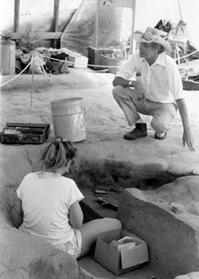 His presence in Williamsburg also brought him into much closer contact with the community of Chesapeake historical archaeologists, whose work he had been admiring from a distance for so many years. Jim had always recommended Cotter's report on Jamestown and the collections there held a great fascination for him. He also got to know Bill Kelso, then commissioner of archaeology for the Commonwealth of Virginia, and had a chance to visit many of the important sites that Kelso and his staff were excavating. But his most important site visits during that year occurred at Flowerdew Hundred, where Southside Historic Sites, Inc., had been excavating for several years. Professor Norman Barka, who had invited Jim to come to Williamsburg, graciously included him in many of Southside's activities that year, and Jim made an important connection with David Harrison, the man who owned the property on which Flowerdew Hundred was located. As it turned out, the draw of Flowerdew would ultimately be too strong to resist. Berkeley BeckonsAt the end of his academic year in Williamsburg, Deetz had a tough decision to make. Three schools wanted his services. He had been offered a teaching position at the University of California at Berkeley. William and Mary also made a bid, and Brown matched the offers. Jim and the family decided to head back to the West Coast. Jim Deetz had been given countless offers over his years at Brown. Some were clearly tantalizing and gave him pause; others he simply ignored. I asked him often in those days why he didn't use these situations to his advantage and ask Brown for more money. His reaction was one of disgust at the very idea. He believed that such jockeying was lacking in honor, and he made his disapproval of such behavior clear to his students. He did not take the job at Berkeley for the money. It was time for a change and the opportunity for good colleagueship in the company of so many distinguished anthropologists was too good to pass up, even though leaving his many friends in Plymouth was painful. The move to Berkeley gave Jim the opportunity to develop a new graduate training program but in the context of a much larger and more-established department. There was no doubt that the department fully covered the four fields, and among Berkeley's large and distinguished faculty, Jim would find many colleagues whose friendship was more reminiscent of the relationships he developed during his years at Santa Barbara. It also did not take Jim long to attract a large following of students. In his early years at Berkeley, many of his most talented undergraduates were encouraged to stay on for graduate work, but he also accepted several students from his Brown/Plymouth network. He needed a place to train them, a need that soon brought him back to the Chesapeake and Flowerdew Hundred. 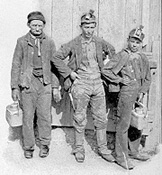 For a few years, however, Deetz trained students in fieldwork at the site of Somersville, a late 19th-century coal-mining town in the hills about an hour north of Berkeley. When he initiated this project, he had just taken over the directorship of the Lowie Museum, a post he would hold for eight years (1979-1987). He was able to recruit a number of the museum's long-time staff members to help out on the project, and with the assistance of some of his first graduate students, Deetz mounted a program of excavation that featured more than 200 undergraduates working in coordinated teams of a dozen under the supervision of more experienced undergraduates and graduate students. Done over several years, the Somersville excavation examined the dynamics of interaction among households in a multiethnic community. It is also one of the few archaeological projects ever to be featured in TV Guide (Deetz 1980), a prelude to the first broadcast of the PBS program Other People's Garbage. Flowerdew Hundred became the place where Jim Deetz fully developed his talents as a teacher of field schools. He ran an undergraduate program at Flowerdew beginning in summer 1981 and held several successful summer institutes funded by the National Endowment for the Humanities there in the late 1980s and early 1990s. Jim started the long-term field project at Flowerdew Hundred explicitly to train his undergraduate and graduate students. Several hundred Berkeley undergraduates went through the program, as did more than 100 university faculty members. Towards the end, Flowerdew began to serve as a sort of "spa" for some of the latter, and Deetz harbored the idea of establishing a program specifically for archaeologists who, as he put it, "were on the verge of burnout and needed to get back on track." As he demonstrated summer after summer at Flowerdew, Deetz had the ability to reach any and every student, no matter where they might have been in their careers. No doubt he would also have been successful if he had ever acted on the idea to establish a summer program for weary and discouraged veterans. No one who participated in the Flowerdew summer school will ever forget the experience. In addition to the digging, there were the outstanding meals prepared by son Geoff, who, like other of Jim's kids, had turned into a culinary artist. There was also the music. No matter who was sitting in, Jim could always be counted on to break out his old-time banjo, and those who knew him well will never forget that look of steely determination on his face as he concentrated on his clawhammer technique. Another of the excitements of Flowerdew was the all-too-frequent early morning appearance of another kind of "rolling thunder review," only these concerts didn't feature Bob Dylan and Joan Baez. 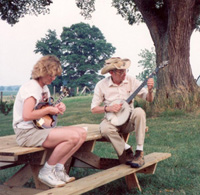 It was part of Jim's plan for the research to be reported on mainly by his graduate students, and indeed several excellent dissertations came out of the Berkeley field school at Flowerdew. But Jim also had his own chances to reflect on the significance of the research undertaken there. His first effort was detailed in an article published in 1987 (Deetz 1987a) and then presented more broadly in the 22 January 1988 issue of Science (Deetz 1988a). Based on a playful exercise with some of his students and Flowerdew staff, Deetz returned to the kind of analysis that had intrigued him in examining the pipestems from the Howland site 30 years before. The result was an application of the Harrington pipe stem dating formula that measured the intensity of site occupation spans. Using the Harrington histograms, Deetz was able to establish temporal patterns in the duration of site occupation that could be examined spatially to see if there were any trends related to aspects of areal and regional settlement dynamics. Deetz recalled that, after reading his article in Science, "Pinky Harrington wrote me a letter, which characteristically I didn't answer. But he told me, 'Gee, finally, after all these years somebody finally used it for the purpose that I designed it for'" (Deetz, 1989, pers. comm.). Towards the end of his tenure on the Berkeley faculty, Deetz completed a book on the work at Flowerdew. Published by University Press of Virginia in 1993, Flowerdew Hundred: The Archaeology of a Virginia Plantation, 1619-1864 functions much like Deetz's earlier books (Deetz 1993). It distills the essence of his thinking over the time that had elapsed since his last book, in this case more than 15 years. Although many of his arguments derive from his maturing conception of the relationship between the written and material records (the key dynamic underlying his ideas about the importance of folklife studies to historical archaeology), this book cannot be fully appreciated without some background on the research he conducted in South Africa, research interests that began to form almost immediately after he arrived in the country in fall 1984. He had gone there to teach historical archaeology as visiting professor of anthropology at the University of Cape Town, a posting suggested to him by an old friend and colleague, Nick van der Merwe. The Beginnings of Comparative Colonial ArchaeologyDeetz's visits to South Africa, beginning with his first teaching experience at Capetown in the early 1980s, helped to usher in the current interest in the global scale of comparative research among many historical archaeologists. One of the basic tenets of historical archaeology set forth in Flowerdew Hundred is, "Historical archaeology is international in scope and must adopt an international comparative method to be of maximum value" (Deetz 1993:163). Deetz first made this point in a little paper he presented at the 1986 meeting of The Society for Historical Archaeology in Sacramento, titled "Some Issues of Scale in Historical Archaeology." This paper draws attention to the parochialism inherent in the practice of historical archaeology and through examples drawn from his previous work as far back as La Purisima and from what were then very recent observations from South Africa, Deetz advocated assemblage-level artifact comparisons at the global scale. He saw these exercises not only as an entry point into important aspects of the international economy but as a way of understanding significant differences in the meaning of objects as they were incorporated into the lives of both those who did the colonizing and those who were colonized. Much like the four levels of behavior he presented in Invitation to Archaeology in 1967, his Sacramento paper identified similar levels or scales at which comparison became valuable, once the global or international perspective was adopted. That first trip to teach at Capetown clearly stimulated Jim to write down these ideas, which he first made clear in print in 1988 (Deetz 1988b). Deetz also more than accomplished the purpose that van de Merwe had in mind when he extended the invitation to teach in South Africa. Jim met archaeologists Carmel Schrire and Martin Hall, who had already begun to do research on historic sites there, and he established the first course in historical archaeology at the University of Capetown. Over the next several years, he returned several times, on one occasion to work with Carmel in her excavation of Oudepost, the Dutch fort in the far Western Cape. Carmel has gone on record about how important Jim's advice was to the success of her project. They collaborated on the analysis of the artifact assemblage, notably extending the Harrington technique to Dutch pipes (Schrire et al. 1990). As interested as he was in the Dutch, Deetz wasn't comfortable with initiating a major research project on people whose language and culture were so unfamiliar. Instead, through Simon Hall of the Albany Museum, he was introduced to Grahamstown and the Eastern Cape province. As he once described the opportunity to me, "more than anywhere I've ever seen, the Eastern Cape gives us a situation that's just perfect in that 5,000 English were dumped in there at one time with little follow-up immigration. Planted in place, they put together a world very quickly, which was more English than not" (Deetz, 1989, pers. comm.). Jim was able to take advantage of this new research opportunity with the help of Berkeley students, both undergraduate and graduate. He conducted three seasons of fieldwork in the Grahamstown area, the most productive being at the site of Salem Hall, where he collaborated with his Berkeley graduate student Margot Winer. Other of his students also went to South Africa with Jim's encouragement or through the contacts he had established with Carmel Schrire and Martin Hall (for example, Markell et al. 1995). There is no question that Deetz's many visits to South Africa to do fieldwork, teach, and consult over more than a decade were a major catalyst for the development of that country's research program in historical archaeology. During one of these trips in spring 1988, Jim, along with Colonial Williamsburg chief curator Graham Hood, delivered the keynote address at the annual meeting of the South African Museums Association being held that year in Stellenbosch. There he met Patricia (Trish) Scott, who had traveled to the meeting from her home in Grahamstown. Scott had recently received her MA in History and was looking for an opportunity to get back into museum work (at the time she was on the senior administrative staff of Rhode University). Over the next several years, they developed a very productive professional relationship as well as a personal one (Jim had separated from first wife, Jody, in 1983). For the next seven years, Deetz pursued his research on the British settlement of the Eastern Cape and continued his summer program at Flowerdew. His made his last trip to South Africa in 1993. A Final Cross-Country MoveThe early 1990s were an extremely busy time for Jim. He was completing his fieldwork in the Eastern Cape, running his very successful field program at Flowerdew Hundred, and completing the manuscript that was published as Flowerdew Hundred in 1993. His life became even more complicated when he was offered an endowed chair at UVA in 1993. Although David Harrison, the sponsor of his work at Flowerdew Hundred, had been discussing such an arrangement with Jim for some time, the negotiations weren't finalized to everyone's satisfaction until that year. Deetz came out in fall 1993 as a visiting professor of New World studies and occupied the chair the next fall, becoming the Harrison Professor of Historical Archaeology at the University of Virginia in 1994. He held this position until his death. Also in 1994, Deetz was appointed a trustee at Plimoth Plantation, renewing what became a most productive relationship with the museum he had helped create 25 years before. As part of his negotiations with UVA, Deetz was able to secure the transfer of several of his graduate students who had just started working with him at Berkeley as well as the appointment of Patricia Scott as a research associate in the anthropology department. During Jim's years in Charlottesville, Scott would become a key collaborator on his research and teaching, and on his final book. After Jim was divorced in 1997, she became his second wife. With her help, and with the help of a new generation of students, Jim was able to return to a project that had so fascinated him in the late 1960s when he was busy remaking the 1627 Pilgrim village: the historical ethnography of 17th-century Plymouth Colony. Very soon after he had come to Brown, Deetz began recruiting graduate students to work on Plymouth Colony records. One of the first master's theses he supervised was a study of the "wayward Pilgrim," modeled after Kai Erickson's classic study of social deviance in Massachusetts Bay Colony (Erickson 1966). He also encouraged several of his colleagues in the Brown anthropology department to work with the Plymouth material, and he established a long-term relationship with John Demos at Brandeis. Demos would provide the students to work on the plantation's biographical reconstruction of Plymouth Colony's population. Despite all of the excellent primary research done under his overall direction between 1967 and 1978, in both the documents and in the ground, Deetz still had much he wanted to do. Some of this work was accomplished through seminars at Berkeley. One of his most popular was the class he ran on the analysis of probate inventories. By 1987 he and his students had developed a very innovative technique for interpreting the use of space with room-by-room inventories, which Jim reported on at that summer's Dublin Seminar on New England Folklife (1987b). But he did not return to the Plymouth data in earnest until he had become established at UVA. 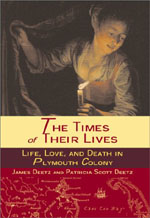 Beginning in fall 1996, Jim began to teach a series of seminars on the general topic of historical ethnography. Some were what are called freshman seminars, designed to give new undergraduates an intensive introduction to a specific subject along with an opportunity to practice their writing skills. Others were upper-level classes that benefited greatly from the participation of his graduate students. He used these classes, among the last he was to teach, to pull together many of the ideas he had been entertaining for nearly three decades. The result is his last book, The Times of Their Lives: Life, Love, and Death in Plymouth Colony, written with his wife Trish and published the year he died (Deetz and Deetz 2000). The last chapter recounts his perspective on the history of the plantation and the role he played in making it what it became -- a truly outstanding example of the outdoor living history museum. Of course, upon his relocation to Charlottesville, Deetz was that much closer to the property where he had been running field schools for more than a decade. He did continue the Flowerdew program for a few more years, two summers as a joint Berkeley/UVA program and finally, the last two summers, as a UVA class. In summer 1995, however, one of his graduate students made what turned out to be the final discovery at Flowerdew, the site of the windmill. This find fulfilled Harrison's quest to locate the earliest windmill in the American colonies, and so he brought an end to the wonderful field program he had sponsored for more than 30 years. 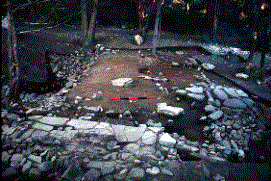 But Deetz did not stay out of the field long. Having begun his classes on the Plymouth Colony material, he decided to return to the Plymouth area. In the current fashion of the day, he chose to reassess or rediscover the archaeology that someone else had done many years before, in this case excavations of the John Howland site done by architect Sidney Strickland in 1937. Over two summers, 1998 and 1999, Jim's graduate students and a UVA field school re-exposed and properly mapped foundations first excavated 60 years before. Jim's reinterpretation of the site is one of his last such analyses (Deetz and Deetz 2000:240-245), and it exhibits the same kind of careful, step-by-step inference that his earlier site accounts contain (e.g., Deetz 1963). That fall, failing health forced Jim out of the classroom for what would be his last class, ending close to 40 years of undergraduate and graduate instruction. Fortunately, he was in better health the next summer when his youngest daughter Kelley was married in Williamsburg. Nearly his entire family was able to be at the wedding, a group that included all of his children and most of his grandchildren. It was great to see them all together one last time. And Finally -- On a Personal NoteFor the heading of his chapter on gravestones in his book In Small Things Forgotten, Jim took a line from one of the many epitaphs he enjoyed: "Remember me as you pass by." Jim chose to be buried among family members in St. Peter's Cemetery in the little town of Westernport, Maryland, about 25 mi. south of his birthplace in the far western panhandle of the state. It is fair to say, that aside from a special effort to pay homage to Jim, most of us won't be passing by his gravestone any time soon, if at all. But we will remember him, all of us, just the same. The memory may simply take the form of seeing a citation in a journal article or book placed there to stereotype Deetz's writings as the work of a "structuralist," "new archaeologist," or any number of other inaccurate labels. Or the memory may come from the opposite experience, an encounter with The Times of Their Lives or In Small Things Forgotten that leads to a serious and rewarding exploration of his scholarly contributions to the fia citation in a journal article or book placed there to stereotype Deetz's writings as the work of a "structuralist," "new archaeologist," or any number of other inaccurate labels. Or the memory may come from the opposite experience, an encounter with The Times of Their Lives or In Small Things Forgotten that leads to a serious and rewarding exploration of his scholarly contributions to the fields of historical archaeology, American studies, and, most significantly, anthropology.But for those of us fortunate enough to have been a student of Jim Deetz, anywhere along the way (Harvard, Santa Barbara, Brown, William and Mary, Berkeley, Cape Town, UVA) , we will all remember his brilliant mind and his amazing presence in the classroom. This presence could be a captivating one. Jim rescued many a lost undergraduate from four years of indifference. At his funeral in Williamsburg on a chilly Saturday morning, I gazed up from my pew and saw a long line of young people, all dressed in black, looking lost and forlorn. It made me sad at first but then I realized they wouldn't be there, so visibly in mourning, if not for Jim's brilliance as a teacher and mentor and his warmth and openness as a person. Some were his serious students. Others were probably just fans. In a way I was envious. In 1996 he presented me with a copy of his revised In Small Things Forgotten and wrote in the front, "For all the good times, Cheers, Jim." My closest times with him had been in the past and they were, indeed, some of the very best times of my life. But regardless of how often we saw one another in later years, the opportunity to learn something new, or just to think about things in a different way, was always there. A mental spark from Jim was such a great pleasure, in large part because it was always a two-way street for him. It is difficult for me to imagine the practice of historical archaeology without Jim Deetz. I know he had strong opinions about what was happening to the field. In fall 1994, Steve Mrozowski and I organized a session for the Washington, DC, SHA meetings on historical archaeology and the culture concept. Program chair Henry Miller found the topic to be a compelling one and decided to make it the plenary session for that year's meeting. I asked Jim to put together his thoughts on the subject as the keynote. Although the paper he wrote was never published, I think it is important for us to consider most seriously what Jim had to say (with some help from his friend Henry Glassie) at the 1995 plenary: What is the current status of the concept of culture; is it still healthy, or rather is it suffering from some terminal affliction, or even worse, has it met with what some would see as a timely demise? There are those who have already erected the grave marker with what seems an almost morbid, and certainly, cynical satisfaction. Remember Kent Flannery's Old Timer, who was forced into early retirement because he believed in culture? I must admit that I find this situation both sad and deeply alarming. Leaving aside the simple fact that behavior can be seen as a product of culture, regardless of which of the many definitions we choose to employ, such a perspective is a reflection of a century or more of thoughtful insight. Are we really prepared to jettison the works and thoughts of people such as E. B. Tylor, Franz Boas, A. L. Kroeber, Leslie White, or Claude Levi-Strauss, to name but a very few? I think not, and would suggest that what might make better sense would be to create parallel and separate agendas, one for those who find the culture concept useful in reaching some basic understandings of the human condition, and the other for those who choose behavioral explanations. The profession of historical archaeology has been fortunate to have among its long-term practioners a scholar like Jim Deetz who will be remembered for his commitment to anthropology and for his ability to communicate the significance of archaeology to all audiences. Jim's gifts were on display every time he went into the classroom, every time he sat down and got to work on his well-worn typewriter, and every time he kneeled down to have a closer look at a soil stain or artifact in the ground. AcknowledgementsOver two days in late August 1989, Jim Deetz and I sat in the living room of his house in the Berkeley hills talking about his career up to that point, an interview encouraged by my colleagues and fellow Deetz students, Mary Beaudry and Anne Yentsch (who were putting together what is now fondly referred to as the Deetzschrift). The results of that conversation, patiently transcribed from cassette by my former secretary, Nan Reisweber, didn't make it into a volume, but they are the source of Jim's voice in this memorial essay. I have also drawn on material gathered for my 1997 Harrington Award presentation, based on another formal interview with Jim, who by that time had moved his living room to Charlottesville, Virginia. On that occasion, we focused on identifying various photographs that chronicled his life, which had been graciously provided to me by eldest daughter Tonia Rock, by Gene Prince and Maria Franklin, and by Jim himself. The final version of this memorial could not have been prepared without the contribution of Jim's wife, Patricia Scott Deetz, son Eric Deetz, daughter-in-law Anna Agbe-Davies, and son-in-law Seth Mallios. Chris Fennell, who helped bring Jim into the Internet age, gave an earlier draft a thorough reading and has been very supportive throughout the preparation of this memorial essay, which has also benefited from review and comment by Greg Brown, Andy Edwards, and Kathleen Bragdon. Finally, in his capacity as memorial editor, Bill Lees helped me bring this essay to completion. I thank him for giving me this assignment and for his persistence in seeing it through to completion. Any errors in this portrait of Jim Deetz's career are, of course, my responsibility alone. ReferencesANDERSON, JAY
1965 A Corpus of Chumash Basketry. UCLA Archaeological Survey Annual Report, pp. 193-275. Department of Anthropology, University of California, Los Angeles.
1960b Excavations at the Joseph Howland Site (C5), Rocky Nook, Kingston, Massachusetts, 1959: A Preliminary Report. Howland Quarterly, 24(2&3):1-12. 1960c The Howlands at Rocky Nook: An Archaeological and Historical Study. Howland Quarterly, 24(4):1-8. 1963 Archaeological Investigations at La Purisima Mission. Archaeological Survey, Department of Anthropology, Annual Report 1962-63. University of California, Los Angeles, pp. 161-241. 1964 A Datable Chumash Pictograph from Santa Barbara County, California. American Antiquity, 29(4):504-506. 1967 Invitation to Archaeology. Natural History Press [Doubleday] for The American Museum of Natural History, Garden City, NJ. 1969 The Reality of the Pilgrim Fathers. Natural History, 78(9):32-44. 1972 Ceramics from Plymouth, 1620-1835: The Archaeological Evidence. In Ceramics in America, Ian M. G. Quimby, editor, pp. 15-40. University Press of Virginia, Charlottesville. 1977 In Small Things Forgotten: The Archaeology of Early American Life. Doubleday, Anchor Press, New York. 1980 Other People's Garbage. TV Guide, 10 May:33-34. 1987a Harrington Histograms Versus Binford Mean Dates As a Technique for Establishing the Occupational Sequence of Sites at Flowerdew Hundred, Virginia. American Archaeology, 6(1):62-67. 1987b Plymouth Colony Room-by-Room Inventories, 1633-1684. Manuscript abstracted in Early American Probate Inventories. Dublin Seminar for New England Folklife Annual Proceedings, vol. 12:182. Boston. 1988a American Historical Archaeology: Methods and Results. Science, 239:362-367. 1988b Material Culture and World View in Colonial Anglo-America. In The Recovery of Meaning: Historical Archaeology in the Eastern United States, Mark P. Leone and Parker B. Potter, Jr., editors, pp. 219-233. Smithsonian Institution Press, Washington, DC. 1989 Foreword. In Cemeteries and Gravemarkers: Voices of American Culture, Richard E. Meyer, editor, pp. ix-xiv. UMI Research Press, Ann Arbor, MI. 1993 Flowerdew Hundred: The Archaeology of a Virginia Plantation, 1619-1864. University Press of Virginia, Charlottesville. 2001 Cultural Dimensions of Ethnicity in the Archaeological Record. Keynote Address, 28th Annual Meeting of The Society for Historical Archaeology, Washington, DC, 1995. In Plymouth Colony Archive Project, Patricia Scott Deetz and Christopher Fennell, editors. University of Virginia, Charlottesville. http://www.histarch.illinois.edu/plymouth/JDeetzmem6.html.
1965 The Doppler Effect and Archaeology: A Consideration of the Spatial Aspects of Seriation. Southwestern Journal of Anthropology, 21(3):196-206. 1971 Some Social Aspects of New England Colonial Mortuary Art. In Approaches to the Social Dimensions of Mortuary Practices, James A. Brown, editor, pp. 30-38. Memoirs of the Society for American Archaeology, no. 25.
© By Marley Brown III
© 2019 Copyright and All Rights Reserved by |